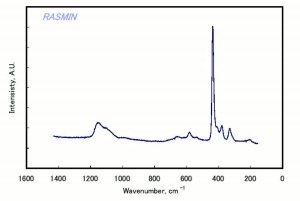Difference between revisions of "Zincite"
Jump to navigation
Jump to search
| Line 7: | Line 7: | ||
red zinc ore; red zinc oxide; zincite (Fr., Port.); Zinkoxid (Deut.); zinkiet (Ned.) | red zinc ore; red zinc oxide; zincite (Fr., Port.); Zinkoxid (Deut.); zinkiet (Ned.) | ||
| − | [[[SliderGallery rightalign|zinciteRS.jpg~Raman]]] | + | [[[SliderGallery rightalign|zinciteRS.jpg~Raman (RASMIN)]]] |
== Physical and Chemical Properties == | == Physical and Chemical Properties == | ||
| Line 16: | Line 16: | ||
* Fracture = conchoidal. | * Fracture = conchoidal. | ||
* Luster = adamantine. | * Luster = adamantine. | ||
| − | * | + | * Streak = orange-yellow |
{| class="wikitable" | {| class="wikitable" | ||
Latest revision as of 14:09, 6 December 2022
Description
Naturally occurring translucent orange to red color mineral of Zinc oxide that contains traces of Manganese. Large quantities of zincite have been found in Poland, Italy (Tuscany), Spain, Germany (Saxony), Tasmania and the U.S. (New Jersey). Deep red zincite stones obtained in New Jersey are sometimes cut into gems for costume jewelry. Fluorescent zinc glass is prepared with crushed zincite.
Synonyms and Related Terms
red zinc ore; red zinc oxide; zincite (Fr., Port.); Zinkoxid (Deut.); zinkiet (Ned.)
Physical and Chemical Properties
- Hexagonal crystal system.
- Perfect cleavage in one direction.
- Usually massive.
- Fracture = conchoidal.
- Luster = adamantine.
- Streak = orange-yellow
| Composition | ZnO |
|---|---|
| Mohs Hardness | 4.0 |
| Density | 5.4-5.7 g/ml |
Resources and Citations
- Mineralogy Database: Zincite
- G.S.Brady, Materials Handbook, McGraw-Hill Book Co., New York, 1971 Comment: p. 889
- Encyclopedia Britannica, http://www.britannica.com Comment: "zincite" [Accessed 20 Sept. 2005].
- C.W.Chesterman, K.E.Lowe, Audubon Society Field Guide to North American Rocks and Minerals, Alfred A. Knopf, New York, 1979
- Wikipedia: http://en.wikipedia.org/wiki/Zincite (Accessed Sept. 20, 2005)
